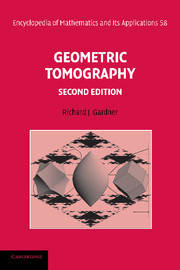Book contents
- Frontmatter
- Contents
- Preface to the second edition
- Preface
- 0 Background material
- 1 Parallel X-rays of planar convex bodies
- 2 Parallel X-rays in n dimensions
- 3 Projections and projection functions
- 4 Projection bodies and volume inequalities
- 5 Point X-rays
- 6 Chord functions and equichordal problems
- 7 Sections, section functions, and point X-rays
- 8 Intersection bodies and volume inequalities
- 9 Estimates from projection and section functions
- Appendixes
- References
- Notation
- Author index
- Subject index
1 - Parallel X-rays of planar convex bodies
Published online by Cambridge University Press: 05 June 2013
- Frontmatter
- Contents
- Preface to the second edition
- Preface
- 0 Background material
- 1 Parallel X-rays of planar convex bodies
- 2 Parallel X-rays in n dimensions
- 3 Projections and projection functions
- 4 Projection bodies and volume inequalities
- 5 Point X-rays
- 6 Chord functions and equichordal problems
- 7 Sections, section functions, and point X-rays
- 8 Intersection bodies and volume inequalities
- 9 Estimates from projection and section functions
- Appendixes
- References
- Notation
- Author index
- Subject index
Summary
In this chapter our goal is to investigate the tomography of convex bodies in the plane. The requisite concepts of an X-ray and Steiner symmetral of a planar convex body are introduced in such a way that no knowledge of measure theory or Lebesgue integration is necessary. Furthermore, the reader can absorb the new ideas while avoiding the technicalities of higher-dimensional spaces. More general definitions are postponed until Chapter 2. (Occasional reference is made to these, but this is merely for cross-reference.) Granted some (but by no means all) of the background material in the first four sections of Chapter 0, and apart from references to a couple of auxiliary facts, the chapter is self-contained.
An X-ray of a convex body gives the lengths of all the chords of the body parallel to the direction of the X-ray. Corollary 1.2.12 states that there are four directions such that every convex body is determined, among all convex bodies, by its X-rays in these directions. Given a convex body, Theorem 1.2.21 says that there are three directions allowing the body to be distinguished from all others – “verified” – by the corresponding X-rays. A practical method by which every convex polygon can be “successively determined” by three X-rays, the direction of each depending only on the previous X-rays, is provided by Theorem 1.2.23.
Information
- Type
- Chapter
- Information
- Geometric Tomography , pp. 28 - 59Publisher: Cambridge University PressPrint publication year: 2006
